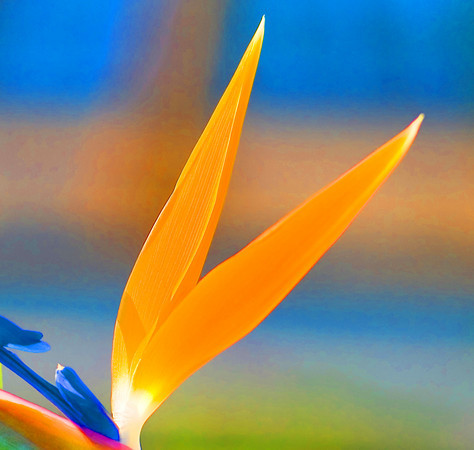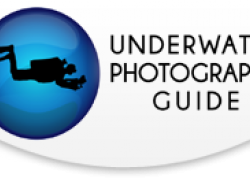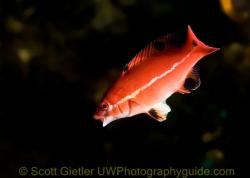How to Achieve a Good Bokeh Effect
Bokeh, originally spelled Boke, is the Japanese word for fuzzy, or blur. Photographers often try to get a blurred background in order to isolate the subject. Isolating the subject is an important part of photography, and professional photographers will go to long lengths in order to achieve this. When the blurred background has a high aesthetic quality to it, the photo is said to have achieved "good bokeh".

A large wide-open aperture and a beautiful, distant background gave this photo great Bokeh. Nikon 105mm lens, F2.8
Beginner photographers often start out trying to get the entire subject and background in focus. Compact cameras, which have a large depth of field because of their smaller sensors, are very good at this.
However, as your photography progresses, many photographers want to creatively isolate the subject by getting a blurred background. If a background has a pleasingly blurred background, it's said that the photo has good "bokeh".
So technically, when photographers talk about bokeh, they are not just talking about the amount the background is blurred, but also the quality of the blurring.

The wide-open aperture gives the pastel flowers in the background a circular shape. Nikon 200-400mm lens, F4
Understand Aperture blades and Bokeh
The aperture of your lens is an adjustable opening, consisting of several aperture blades that can open or close the opening when you stop down your aperture. Because of this design, aperture openings are not perfectly round, but can take on the shape of a polygon. Better lenses have more aperture blades, and the opening is closer to a circular shape. In general, the more aperture blades, the rounder the opening, and the more pleasing the bokeh will be. This is why bokeh can vary in different lenses. When a cheaper lens is stopped down, the highlights in the background will have a hexagonal shape. When a high-quality lens is wide open, the aperture will be very close to a circle, resulting in beautiful highlights and wonderful bokeh.

Aperture Blades
Factors affecting Bokeh
Type of camera, and sensor size
Quality of the lens. Better lenses often produce better bokeh
Focal length of the lens - the longer the focal length, the easier it will be to get a good bokeh
Depth of field - to achieve a good bokeh, you want a small depth of field
- Aperture - a larger aperture will have a smaller depth of field, and a better bokeh
- Distance from subject - the greater the magnification, the smaller the depth of field will be.
- Camera sensor size. Full frame sensors will have a smaller depth of field at the same F-stop.
I often choose my Nikon 105mm lens when I want to achieve a nice bokeh in an underwater photo.

F1, 60mm lens + 1.4x teleconverter. Even 60mm lenses can give a nice background when at maximum magnification.
Top tips for great bokeh
Tips for compact camera users: Use F2.8 (or the largest aperture), zoom in all the way, get very close to the subject, make sure the background is far away.
Dslr shooters - shoot at a large aperture like F7 or F9 to blur the background. If you are using a 60mm lens, you will need an even larger aperture like F4 for similar results, but I prefer the end results of a longer lens. Try F2.8 for an even more extreme effect.
Another tip in getting the best bokeh is choosing a pleasing background. Pastel or complimentary colors work well. The further away the background is in the subject, the more the background will be blurred. And if you are still not satisfied with the results, you can always use a Gaussian blur in Photoshop.
A special tip - if you are shooting your lens wide open, which means at maximum aperture, the Bokeh will take on a special quality because the aperture is in a spherical shape.
Because you are using a narrow depth of field, the point of focus must be carefully chosen.
Be sure to focus on the eyes or rhinophores of the subject
If you camera has moveable focal points, try moving them and use the rule of thirds. Otherwise lock focus and recompose
Try different lighting, but front lighting with few shadows often works well
Remember - when using strobes, your shutter speed will control the exposure of your background. To achieve the best bokeh, your background must be perfectly exposed. When shooting at small apertures, make sure your ISO is low, ISO 100 or ISO 200, and your shutter speed is higher than normal.
If using a telephoto lens topside, you'll usually want a fast lens with largest aperture of F2.8 or F4 (or an even faster lens) for good bokeh

Nice blurred background with good bokeh. F7, 105mm lens
Further reading
Lens choice and composition
Aperture and depth of field
Choosing your macro lens for underwater photography
Nice Bokeh in your macro photos

Nudibranch photo by Mike Bartick, from Anilao. 60mm lens, F5.

RECOMMENDED ARTICLES
SUPPORT THE UNDERWATER PHOTOGRAPHY GUIDE:
The Best Service & Prices on u/w Photo Gear
 Visit Bluewater Photo & Video for all your underwater photography and video gear. Click, or call the team at (310) 633-5052 for expert advice!
Visit Bluewater Photo & Video for all your underwater photography and video gear. Click, or call the team at (310) 633-5052 for expert advice!
The Best Pricing, Service & Expert Advice to Book your Dive Trips
 Bluewater Travel is your full-service scuba travel agency. Let our expert advisers plan and book your next dive vacation. Run by divers, for divers.
Bluewater Travel is your full-service scuba travel agency. Let our expert advisers plan and book your next dive vacation. Run by divers, for divers.































